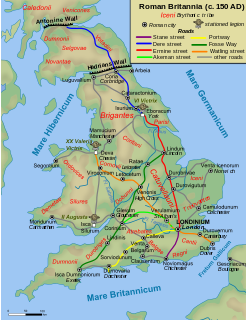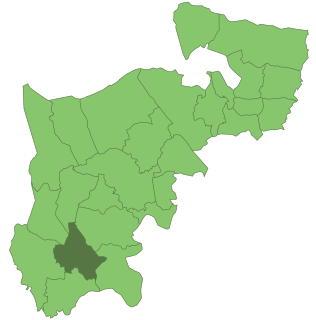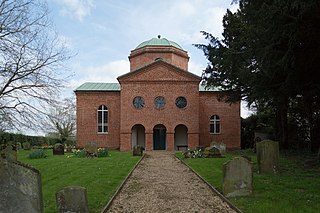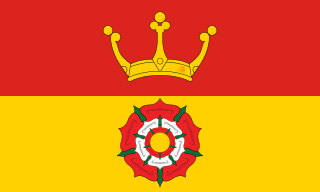
Calleva Atrebatum was originally an Iron Age settlement, capital of the Atrebates tribe, and subsequently a town in the Roman province of Britannia. Its ruins lie to the west of, and partly beneath, the Church of St Mary the Virgin, Silchester, in the county of Hampshire. The church occupies a site just within the ancient walls of Calleva although the village of Silchester itself now lies about a mile to the west.

The Roman road from Silchester to Bath connected Calleva Atrebatum (Silchester) with Aquae Sulis (Bath) via Spinae (Speen), Cunetio and Verlucio. The road was a significant route for east-west travel and military logistics in southeast England during the 1st to 5th centuries.

Newgate was one of the historic seven gates of the London Wall around the City of London and one of the six which date back to Roman times. From it, a Roman road led west to Silchester, Hampshire. Excavations in 1875, 1903 and 1909 revealed the Roman structure and showed that it consisted of a double roadway between two square flanking guardroom towers.

Reading Museum is a museum of the history of the town of Reading, in the English county of Berkshire, and the surrounding area. It is accommodated within Reading Town Hall, and contains galleries describing the history of Reading and its related industries, a gallery of artefacts discovered during the excavations of Calleva Atrebatum, a copy of the Bayeux Tapestry, finds relating to Reading Abbey and an art collection.

Turgis Green is a small hamlet in the civil parish of Stratfield Turgis in the English county of Hampshire. It is in the civil parish of Hartley Wespall. It contains six Grade II listed buildings and a Grade II listed milestone.

Basingstoke is a constituency represented in the House of Commons of the U.K. Parliament. With the exception of a 1923-1924 Liberal Party MP, since modern creation in 1885 it has elected Conservative MPs, so has been a Conservative safe seat. The closest it came to a non-Conservative victory was in 2001, when they were returned with a three-figure majority. The current MP is Maria Miller.

North East Hampshire is a constituency represented in the House of Commons of the UK Parliament since 2015 by Ranil Jayawardena, a Conservative.

Ermin Street or Ermin Way was a Roman road in Britain. It linked Glevum (Gloucester) and Corinium (Cirencester) to Calleva (Silchester).

Stratfield Turgis is a small village and civil parish in the north-east of the English county of Hampshire.

Feltham was an urban district in the former county of Middlesex, England from 1904 to 1965.

Hartley Wintney Football Club is a semi-professional football club based in the village of Hartley Wintney, England. They are currently members of the Southern League Premier Division South and play at the Memorial Playing Fields. The club nickname of 'the Row' stems from the fact that Hartley Row was a hamlet since subsumed by the spread of Hartley Wintney itself.

Stratfield Saye is a village and civil parish in the Borough of Basingstoke and Deane and the English county of Hampshire.

Port Way or the Portway was a Roman road in Britain. It is sometimes taken to be the entire major route between Roman Londinium and Durnovaria, although it more precisely refers to the section of that route between Calleva of the Atrebates and Sorviodunum.

Staines Bridge is a road bridge running in a south-west to north-east direction across the River Thames in Surrey. It is on the modern A308 road and links the boroughs of Spelthorne and Runnymede at Staines-upon-Thames and Egham Hythe.

Cranbrook railway station is a disused English station which was on the closed Hawkhurst Branch in Kent, England.
Koupelo is a village in the Oury Department of Balé Province in southern Burkina Faso. As of 2005 the village had a total population of 653.

The Chichester to Silchester Way is a Roman Road between Chichester in South-East England, which as Noviomagus was capital of the Regnenses, and Silchester or Calleva Atrebatum, capital of the Atrebates. The road had been entirely lost and forgotten, leaving no Saxon place names as clues to its existence, until its chance discovery through aerial photography in 1949. Only 6 kilometres (3.7 mi) of the 62 kilometres (39 mi) long road remain in use.

The Frith is a small univallate Iron Age hillfort to the north of Silchester, Calleva Atrebatum, Roman town. A single bank covers all sides apart from the south east, and is at the most about 5 feet (1.5 m) high on the western edge. A ditch is also traceable for the length of the bank, although at varying states.
Cirencester Amphitheatre was a Roman amphitheatre located in Cirencester, Gloucestershire, England. It has been scheduled as an ancient monument.
This page is based on this
Wikipedia article Text is available under the
CC BY-SA 4.0 license; additional terms may apply.
Images, videos and audio are available under their respective licenses.





















